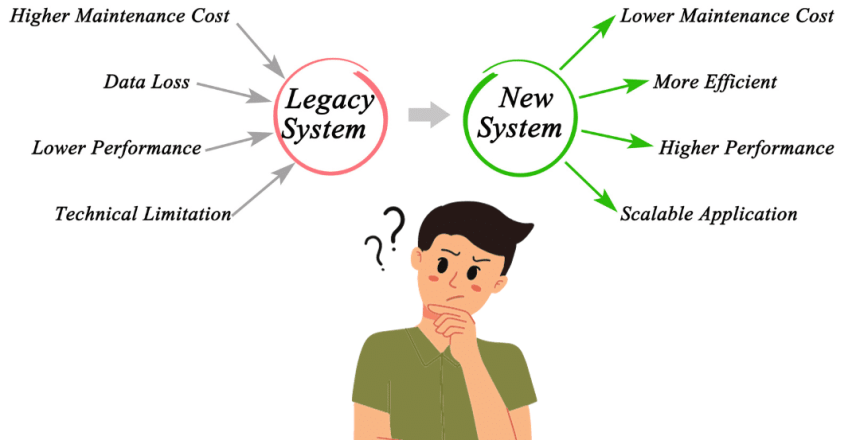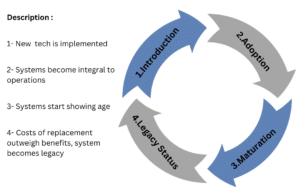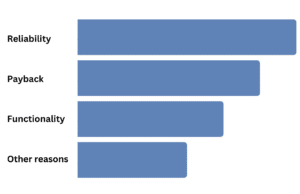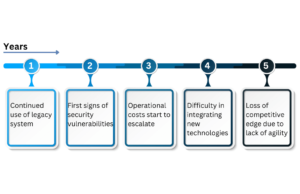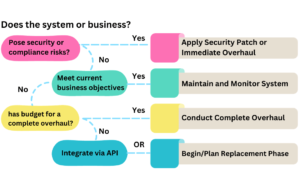In an era marked by rapid technological advancements, the term “legacy systems” often evokes an image of outdated, clunky software or hardware still chugging along within an organization. But make no mistake—these legacy systems are not merely relics of the past; they are integral cogs in today’s business landscape, often handling mission-critical operations.
Did you know that 71% of Fortune 500 companies still use specialized computers known as mainframes for their business operations? Even today, updates to these systems are being made, the latest being in April 2022. This shows how important older technologies remain in today’s business world. (PlanetMainframe.com, 2022)
But why do these outdated systems persist, and what challenges do they pose?
This article aims to demystify the world of legacy systems for Business Leaders and IT Decision-Makers.
We will dive deep into the challenges they present, outline viable strategies for modernization or maintenance, and equip you with the decision-making tools you’ll need to navigate this complex terrain!
Section 1: What Are Legacy Systems?
Definition:
Legacy systems are essentially older software or hardware platforms that are still in use within an organization.
Although they might be considered “outdated” in terms of current technological advancements, they continue to play a vital role.
These systems can be anything from an old version of a software application to an entire computer architecture.
Characteristics:
- Outdated Technology: These systems often run on programming languages or hardware no longer widely supported or used.
- Limited Interoperability: Legacy systems may not easily integrate with newer systems, requiring custom solutions.
- High Maintenance Costs: Maintaining these systems often requires specialized skills, increasing operational expenses.
- Lack of Vendor Support: The original vendors may no longer support the legacy system, leaving organizations to fend for themselves when issues arise.
Brief History: How Do Systems Become “Legacy”?
The path to becoming a legacy system is often the result of a natural technological evolution. Initially, a system is state-of-the-art and fulfills organizational needs efficiently.
Over time, as technology advances and new solutions enter the market, the system starts to age and falls out of alignment with contemporary standards.
It’s not just about the system becoming old; it becomes a “legacy” when the costs and risks associated with replacing or updating it are substantial enough that an organization chooses to maintain it as-is.
Section 2: Why Legacy Systems Persist
Despite the rapid pace of technological innovation, legacy systems continue to hold their ground in the modern business landscape.
In this section, we’ll explore the primary reasons why organizations choose to maintain these aging platforms.
Reliability and Proven Track Record
One of the strongest arguments in favor of legacy systems is their reliability. These systems have often been in operation for several years or even decades.
During this time, they have been tried and tested under various conditions, making them extremely reliable for specific tasks. The notion of “If it ain’t broke, don’t fix it” often prevails here.
For tasks that are mission-critical but do not necessarily need the latest technology, legacy systems can still be the safest bet.
Investment and Sunk Costs
The second major reason why legacy systems persist has to do with economics. Organizations have poured significant financial resources into these systems over the years.
The costs involved aren’t just about the initial purchase but also the long-term investment in customization, training, and maintenance.
Replacing a legacy system would mean not only incurring a new set of costs for the replacement but also writing off the previous investment as a sunk cost—something many organizations are hesitant to do.
Specialized Functionality
Lastly, legacy systems often offer specialized functionalities that are tailor-made for specific industry needs.
This customization makes them uniquely suitable for particular tasks that generic, newer systems may not handle as effectively.
Until a modern equivalent offering the same level of specialization is available, the legacy system remains indispensable.
Other Reasons
In addition to the core reasons we’ve discussed, there are other factors that contribute to the persistence of legacy systems in organizations.
- Regulatory Compliance: In some industries, particularly finance and healthcare, stringent regulatory requirements make it challenging to simply transition away from legacy systems. These systems may have been designed to meet specific regulations, and replacing them would require a monumental effort to ensure that new systems are equally compliant.
- Lack of In-House Expertise to Migrate: Migrating away from a legacy system isn’t just about the technology; it’s also about having skilled personnel who can execute the migration smoothly. Organizations often find themselves in a catch-22 situation: their in-house teams are experts in the legacy systems but may not have the skill set needed to manage a migration to newer technologies. This skills gap can deter organizations from undertaking what already promises to be a complicated, resource-intensive endeavor.
- Other Factors: Other factors may include company culture resistant to change, contractual obligations with vendors, or even the simple fear of the unknown—uncertainties about how a new system will impact operations can be enough to halt migration plans.
Section 3: Challenges Posed by Legacy Systems
Legacy systems, despite their merits, pose a range of challenges to organizations that continue to use them.
Let’s delve into these challenges and understand why they require urgent attention.
Security Risks
The age of legacy systems often means they were not designed with current security standards in mind. This leaves them vulnerable to cyber-attacks and data breaches.
Updating these systems with security patches can be difficult, if not impossible, given that the original vendors may no longer provide support.
Limited Interoperability
Modern business operations often require various systems to work together seamlessly. Legacy systems can create bottlenecks in this regard.
Their dated architecture and software components make it challenging to integrate them with newer, more advanced systems, leading to inefficient workflows and operational delays.
High Operational Costs
While the sunk cost of legacy systems may be high, the ongoing operational costs can be even higher. Specialized skills are needed to maintain and troubleshoot these systems.
Moreover, because they are often inefficient in terms of power usage and system resources, they can be expensive to operate in the long run.
Inhibited Business Agility
In today’s fast-paced business environment, agility is crucial. Legacy systems, due to their inflexibility, can severely limit an organization’s ability to adapt to market changes or to pivot its business model. This can result in lost opportunities and reduced competitive advantage.
Section 4: Risk Assessment and Decision-Making
Understanding the challenges is only half the battle; the next step is to make informed decisions about how to deal with legacy systems.
Here, we’ll explore how you can assess the risks involved and conduct a cost-benefit analysis to make an enlightened choice.
Criteria for Assessing When to Upgrade
If you’re grappling with the question of whether or not to upgrade your legacy systems, here are some criteria to consider:
- Security Vulnerabilities: Are there known security risks that are becoming increasingly difficult to mitigate?
- Operational Efficiency: Is the system leading to bottlenecks, downtime, or workflow inefficiencies?
- Cost of Maintenance: Are you spending more on maintaining the system than what you would on a new installation?
- Compatibility Issues: Is the system becoming increasingly incompatible with other technologies you are using or planning to use?
- Vendor Support: Is support from the original vendor still available, or are you reliant on dwindling third-party expertise?
- Business Objectives: Does the legacy system align with your current and future business goals, such as scalability, agility, and competitive positioning?
How to Conduct a Cost-Benefit Analysis
Conducting a cost-benefit analysis involves comparing the costs of maintaining a legacy system against the benefits of upgrading to a new system. Here’s how you can approach it:
- Identify Costs of Current System: List all the costs involved in maintaining your current legacy system. This includes direct costs like maintenance and support and indirect costs like downtime and loss of productivity.
- Estimate Costs of Upgrading: Research and identify the upfront and ongoing costs of upgrading to a new system.
- Quantify Benefits: Calculate the benefits you stand to gain from upgrading. This could include increased productivity, reduced operational costs, enhanced security, etc.
- Calculate ROI: Use the costs and benefits to calculate the Return on Investment (ROI) for upgrading. If the ROI is positive and meets your organization’s threshold for capital investments, it could be a strong indicator that an upgrade is warranted.
- Risk Assessment: Don’t forget to factor in the risks involved, such as implementation failures, budget overruns, and compatibility issues with existing systems.
- Timeframe: Consider the timeframe over which the costs and benefits will be realized. An upgrade that pays off quickly may be more appealing than one that takes years to justify its costs.
Understanding these criteria and how to weigh them makes business leaders and IT decision-makers better positioned to make informed choices about their legacy systems.
Section 5: Strategies for Dealing with Legacy Systems
Now that we’ve assessed the risks and understood the challenges, it’s time to explore strategies for dealing with legacy systems.
From patching and maintenance to complete overhauls, different approaches come with their unique pros and cons.
Patching and Maintenance
The most straightforward approach is to patch and maintain your existing system.
While this doesn’t address all challenges—especially long-term scalability and potential security issues—it is often the quickest and least expensive short-term solution.
Integration via API or Custom Solutions
If your legacy system holds specialized functionality that you can’t easily replace but lacks the connectivity you need for modern operations, consider an integration approach.
Using APIs or custom-built middleware, you can connect your legacy system to newer applications, gaining some benefits of modernization without fully replacing the existing system.
Phased Replacement
For organizations willing to invest more time and resources, a phased replacement involves gradually replacing components of the legacy system with more modern alternatives.
This allows you to spread the cost and risk over time but requires a detailed, long-term plan.
Complete Overhaul
In some cases, the best course of action may be to completely replace the legacy system with a new, more modern solution.
This approach is usually the most expensive and time-consuming but offers the advantage of implementing current technology designed with today’s business needs in mind.
Conclusion: Navigating the Complex Landscape of Legacy Systems
Legacy systems are a double-edged sword. On one hand, they are tried-and-true workhorses that have served your business for years, if not decades. On the other hand, they pose significant challenges that can’t be ignored, from security vulnerabilities to high operational costs. As we’ve explored in this comprehensive guide, understanding the nature, challenges, and solutions for dealing with legacy systems is crucial for both business leaders and IT decision-makers.
We delved into what makes a system “legacy,” and why such systems still hold a stronghold in modern enterprises. We’ve also examined the reasons these legacy systems persist, from their reliability to the hefty investment they represent. Moreover, we’ve highlighted the challenges these outdated systems bring, affecting your security, interoperability, costs, and business agility.
Our discussion on risk assessment and decision-making aimed to equip you with actionable insights for evaluating your current systems, through criteria such as security vulnerabilities and business objectives. The subsequent section provided a toolkit of strategies for dealing with legacy systems, ranging from basic patching and maintenance to a complete overhaul. The accompanying flowchart serves as a quick decision-making tool to help you navigate these strategic choices.
The task of dealing with legacy systems is not a one-size-fits-all undertaking. It involves careful evaluation, strategic planning, and, often, difficult decisions. However, with the knowledge and tools presented in this guide, you’ll be better positioned to make informed, cost-effective, and strategic decisions that align with your business goals. Whether you choose to maintain, integrate, phase out, or replace, the path forward is now clearer.
Thank you for investing your time in this guide. We hope it serves as a valuable resource as you navigate the complex yet crucial terrain of legacy systems in your organization.
Source :
- https://planetmainframe.com/2022/12/relevance-of-mainframe/
- Samir Abdulnour, Ing., M.Sc.A – Author
- This article was written with the help of an AI language model, ChatGPT. Although the template generated the initial content, it was extensively reviewed, edited, and checked by the author to ensure accuracy and compliance with Google guidelines. The author takes full responsibility for the final product.
For more information and interesting reading :

